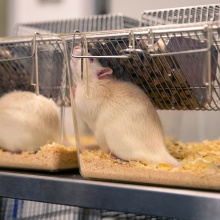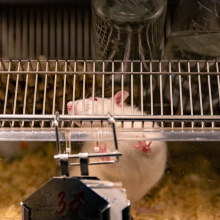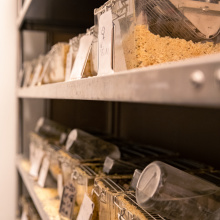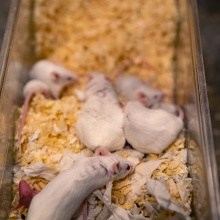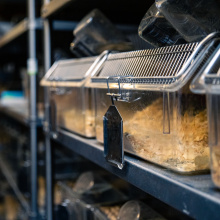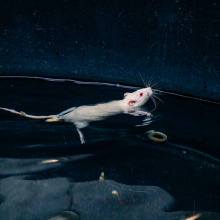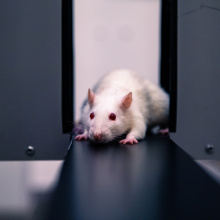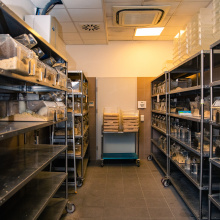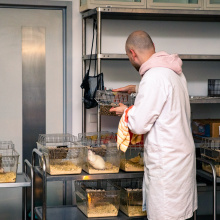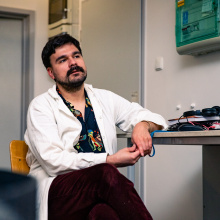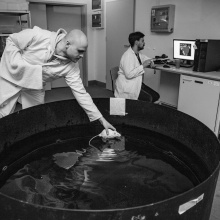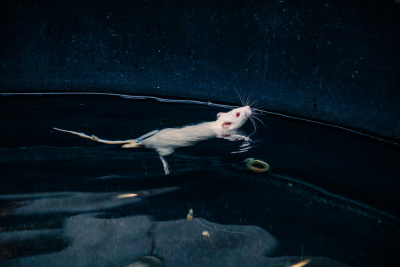
Are animals used for laboratory research subject to pain, insensitivity and ruthlessness? What is it like to work with them? How is this regulated by legislation? These are just some of the issues that, on the occasion of World Laboratory Animal Day, we discuss with dr Dorota Myślińska from the Department of Animal and Human Physiology, Faculty of Biology, University of Gdańsk, Head of the Laboratory of Experimental Animals, Vice-Dean for Internationalisation and Development.
Elżbieta Michalak-Witkowska: - April 24 is World Day for Laboratory Animals, also known as the International Day Against Vivisection. The holiday was established on the initiative of animal advocates as an expression of opposition to research conducted on live animals. Does the UG somehow contribute to the idea of this 'holiday'?
Dr Dorota Myślińska: - Vivisections are not carried out at all. Students learn from films and slides. They can also participate in mild, non-burdensome behavioural tests, e.g. within the course 'Behavioural methods in neurobiology'. - However, they first learn about the current legislation on the protection of animals used for scientific and educational purposes, regulations on animal keeping conditions, proper capture etc. The students really enjoy these classes and are happy to help with research work, e.g. by taming animals (known as handling).
- Can any student, even a novice, participate in research and experiments on animals?
No. Students doing their bachelor's or master's thesis must complete a training course, which is always organised at the beginning of the academic year at the Biology Faculty. This training must meet the statutory requirements, and only after completing it does the Dean issue the student with a special document, the so-called designation for a person participating in experiments. From then on, the student can take part in the research. Even more extensive training must be given to those carrying out or planning such research - experience of working with animals and skills alone are not enough.
- On World Laboratory Animal Day, a lot is said about the need to protect these animals from pain and suffering. Is it really the case that they are mistreated?
There is now a very strong emphasis on animal wellbeing, there are animal wellbeing advisory panels in research centres (known as the Wellbeing Panel) and there is an obligation to employ a veterinarian. The rooms in which the animals are housed must be properly equipped with ventilation, humidifiers, humidity and temperature monitoring. Regulations also specify the size of cages, the material they can be made of and feed parameters (e.g. completely different feeds for adults - so-called Basic, and others for young animals and nursing mothers - Breeding). Appropriate bedding must be used, as well as attractants, i.e. enrichment of the environment, e.g. in the form of tunnels, balls, 'houses' etc.
- So the use of animals for scientific and educational purposes is regulated by law.
Yes. Animal experimentation is not carried out without restrictions - research is authorised by local ethics committees (LKE), there is a possibility to control the research carried out, and there are high penalties for violations.
- Do animals receive anaesthesia before the procedure? Do they receive any painkillers? What does this depend on?
To obtain approval for research from the Local Ethical Committee for Animal Experiments, the applicant must demonstrate which anaesthetics will be used during the study (if any are needed in the study). Sedatives and anaesthetics must absolutely be used for procedures. Inhalation anaesthesia (Isoflurane) is most commonly used as a sedative - it is the least burdensome and least risky. It is obligatory to administer analgesics, e.g. buprenorphine or butorphanol. Animals are also given painkillers after the operation. Of course, antibiotics are also used and surgical instruments are sterilised. The animals' temperature, respiratory rate, etc. are monitored.
- Who sits on the Ethics Committee for Animal Experiments?
There are 12 members in each ethics committee: six representatives of the biological, pharmaceutical, medical, agricultural or veterinary sciences (with at least a doctoral degree and knowledge or experience in the use of animals for scientific or educational purposes), three representatives of the humanities or social sciences (in particular in philosophy, ethics or law, including one representative of organisations whose statutory objectives include the protection of patients' rights), three representatives of social organisations whose statutory objective is the protection of animals.
For an applicant to be granted permission for research, the application must be supported by 70% of Commission members.
- In Poland, approximately 280 thousand laboratory animals are used annually for scientific research. Of these, 200 000 are rodents. In the whole of Europe, this number exceeds 12 million every year. These are usually mice and rats, but also rabbits, mink, birds... What is the situation like at the University of Gdańsk?
At the moment, in the rooms of the Laboratory of Experimental Animals of the Department of Animal and Human Physiology, there are approx. 100 Wistar Han non-breeding rats and about 700 mice of various breeds and strains.
In the animal house, we have three living and breeding rooms and two quarantine rooms. In addition, there are several rooms for behavioural studies, equipped with testing apparatus to monitor various animal behaviours. (Among others, for measuring motor coordination in rats and mice, animal activity tracking systems for measuring spontaneous motor activity, a raised cross maze for studying anxiety behaviour, a Morris water maze for studying working and long-term memory. The premises of the Department of Animal Physiology also include two operating theatres where, for example, neurosurgical procedures are performed.
- What research do we use animals for in our university laboratories?
The research is very diverse. It is difficult to list them all, but I will perhaps mention a few that are currently underway. These include the following: vitamin D (potential application of vitamin D in the treatment of chronic stress), Alzheimer's disease (application of dimethyl fumarate in the treatment of Alzheimer's disease, application of genistein in the treatment of Alzheimer's disease), diabetes (understanding the mechanisms of regulation of bioenergetics and insulin sensitivity in diabetic podocytes to effectively treat diabetic nephropathy), autoimmune skin diseases (understanding the immunomodulatory properties of heat shock proteins to apply them in patients with autoimmune diseases), autism spectrum disorders (study of metabolic pathway dysfunctions in the serotonergic system occurring in these disorders), addiction (knowledge of functional relations between brain structures involved in the mechanism of addiction), learning processes and memory (influence of selected brain structures on bioelectrical activity of the hippocampus connected with these processes).
- Is animal testing necessary nowadays? Is it not possible to test drugs, food and chemicals using alternative methods?
When it comes to drug testing, there is no choice - they have to be tested on animals. But it must be remembered that drugs are first tested on tissue cultures (in situ) and only the most promising agents can be tested on animals. The LKE places great emphasis on this.
Furthermore, the 3Rs principle must be applied legally, i.e.: replacement - the principle based on the replacement of living, sentient animals with non-living material or organisms that do not feel; reduction - the principle based on the reduction of the number of animals used in a test to the minimum necessary to obtain a reliable result; refinement - the principle based on the alleviation of pain and suffering in all circumstances in which an animal may find itself in the test unit.
- Finally, what should be the guiding principle for people who work with laboratory animals daily?
We should remember that 'as a living being capable of suffering, an animal is not a thing. Man owes him respect, protection and care' Art.1.1 of the Act of 21 August 1997 on the protection of animals.
- Thank you for the interview.

